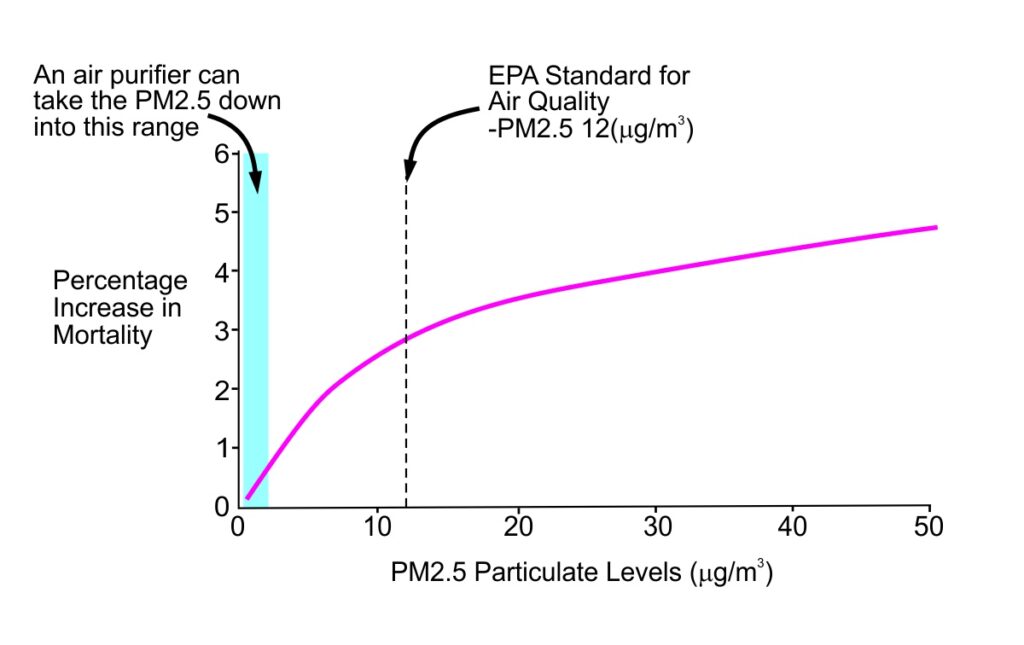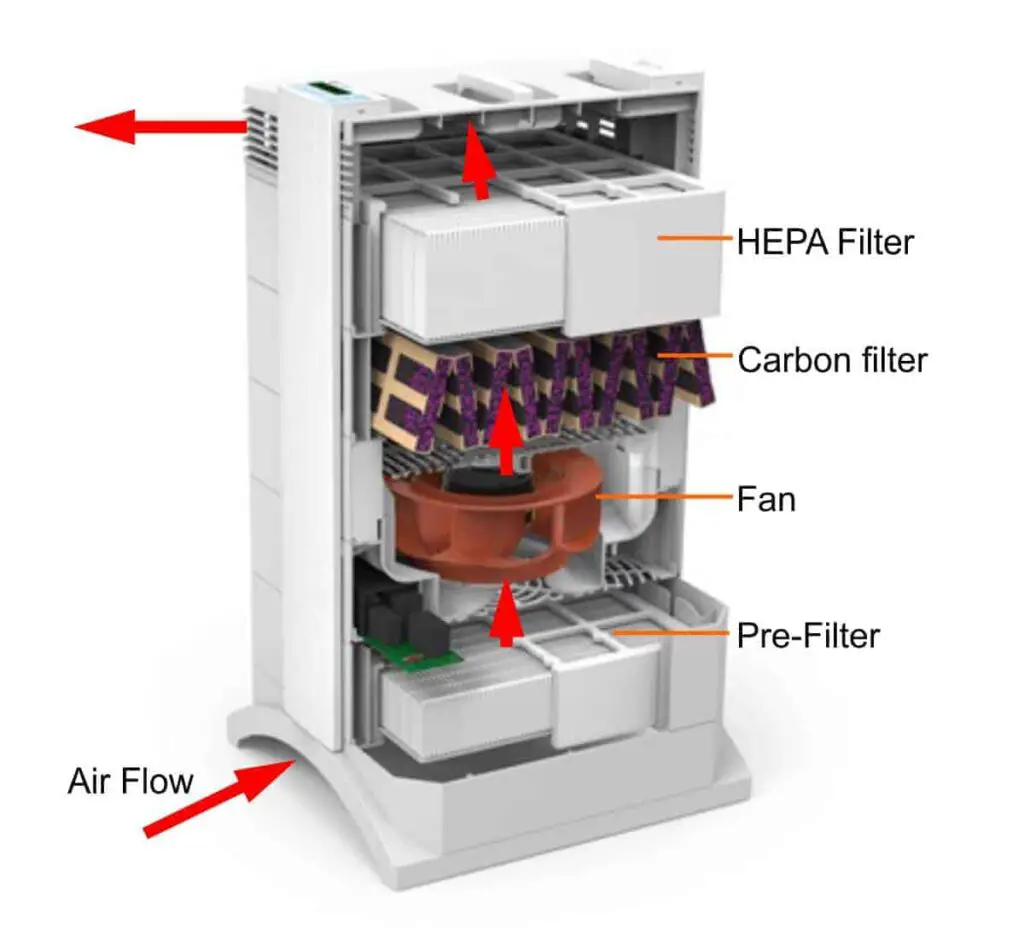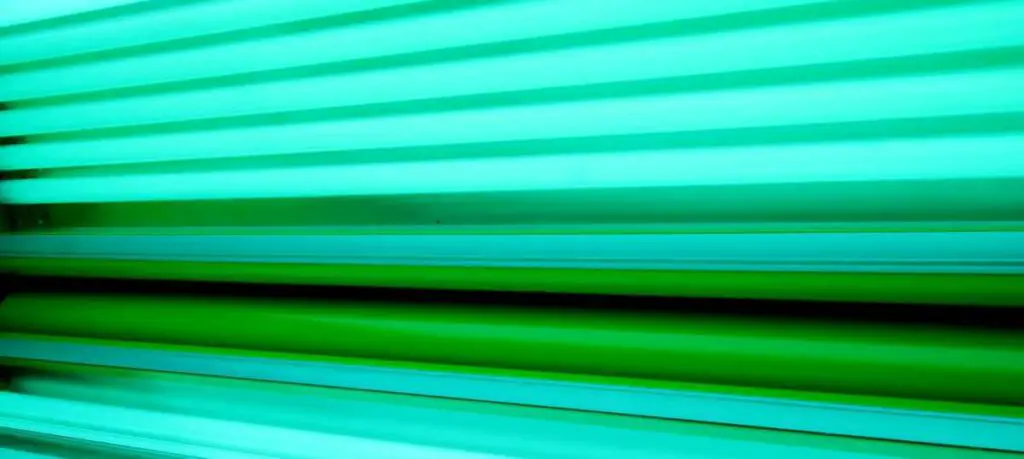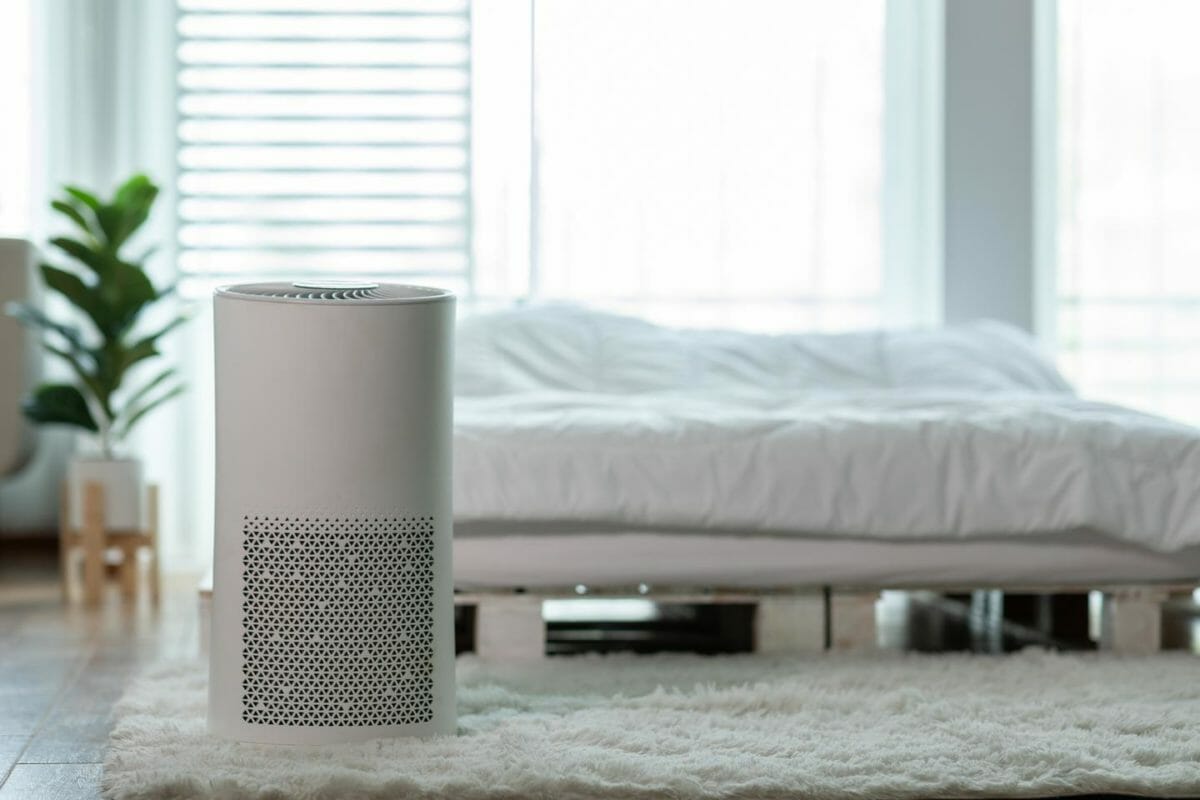We live in an age when unfortunately, air pollution is increasingly being recognized as a problem. This is partly because there are extreme events such as forest fires bringing it to everyone’s attention, as well as nationwide monitoring of air quality so that everyone can check the air quality in their area.
So naturally you will be wondering if you should get an air purifier, and are air purifiers safe?
As a general rule, the typical Fan/HEPA filter/Carbon filter air purifier is perfectly safe in normal use. There are types of air purifier where safety concerns are an issue particularly ozone generators, and to some extent ionizing air purifiers.
Safety is relative, so if there is a tiny risk/consequence doing something been a much bigger risk/consequence of not doing it, it is obviously safer to go ahead. So let us quickly consider the risk to health of not having an air purifier so we can balance the risk of some air purifier technologies against it.
Although it is not well known, the studies of the impact of fine airborne particles, PM 2.5, on human health are looking more and more serious. There have been 3 large studies published in reputable medical journals recently which have shown an increase in mortality in the population at PM 2.5 particle levels that were previously thought to be safe. As a consequence, WHO is now lowered the safe PM 2.5 particle limit to 5 mcg/m³ or less.
According to EPA statistics from 2020, covering 200 million people in the US, 98% of US citizens are living in areas with PM 2.5 concentrations above the new WHO guidelines. These statistics are flattering to outdoor air particle count as they were collected during the COVID epidemic, when activity both industrial and vehicular was reduced, so the real picture with a fully functioning economy may be even worse. Also even these WHO guidelines seem to be aiming for particle count that is higher than those leading to the lowest mortality rates, please see the graph below-

This is for just one health outcome death, but there are more effects of airborne particles on health below is a list of some of them.
Airborne particles have been shown in clinical or epidemiological studies, often multiple studies, to cause-
- Coronary heart disease-heart attacks
- Strokes
- Premature aging of the lungs
- Chronic obstructive pulmonary disease
- Pneumonia
- Cancer
- Lymphoma
- Diabetes
- Skin problems including skin aging
- Autoimmunity
- Osteoporosis
- Diabetes
- Kidney disease
- Dermentia
- Cognitive decline-decrease in thinking ability
- Parkinson’s disease
- Vision impairment-age related macular degeneration and glaucoma
- Impairment of sense of smell
- Sleep disturbance
- Depression
- Anxiety
- Increased risk of psychiatric problems
- Decrease in fertility
- Increased miscarriage
- Exposure during pregnancy linked to neurological problems, asthma, lower IQ in child
- Children-lower intelligence and delayed psychomotor development, faster decline in cognitive function in adulthood
- Children-chest infection, asthma
- Children-increased obesity
- Children-increased psychiatric problems
- Children-death rate increased
- Premature aging?-ultrafine particles speed up several processes involve in aging
- Premature death
In addtion, indoor air quality is often worse than outdoor air quality, for instance we cause a significant amount of air pollution by simply cooking a meal. So logically would all US homes have air purifiers? Yes, but only if they are safe.
Standard Fan/HEPA Filter/Carbon Filter
These air purifiers are entirely safe when used properly. They consist of a fan to move the air through the filters. In general, airborne particles are the usual concern and they have a true HEPA filter which removes these particles extremely efficiently. However, molecules of gaseous pollutants/chemicals can pass straight through the holes in the HEPA filter and so most air purifiers also have an activated carbon filter to capture these. Further information on how air purifiers work can be found here-“How Do Air Purifiers Work?“.
The vast majority of even these air purifiers are made from plastic which releases volatile organic compounds initially–”offgassing”. As time goes on the release of volatile organic compounds from the plastic decreases.
There are rare exceptions. IQ air purifiers are made from plastic which does release volatile organic compounds. Also some air purifiers are made from metal which is powder coated and so do not release volatile organic compound. In general is undesirable from a health point of view to have volatile organic compounds in the air.
This combination of fan/filters is widely recognized as the only really effective method for air purification. However, possibly to make it seem to consumers that their machines are more advanced, many manufacturers especially at the lower end of the market, add additional technologies such as UV light. Some of these technologies raise safety concerns.

Ionizer air purifier dangers/safety
These are also known as an air ionizer, ionic air purifier, ionic purifier or negative ion air purifier. How these work is outlined in this article-“Negative Ion Air Purifier” Some people can feel better and detect an “ionic breeze” from these air purifiers, but does this mean that they are cleaning effectively?
As a general rule, negative ion air purifiers either produce a modest amount of ions and are safe but not very effective, or they produce lots of ions and are moderately effective but may not be very safe. The consumer machines tend to produce modest amounts of ions. Two studies showed that ionized air has no negative health effects on humans, animals, and plants. Another analysis of many studies that have been done found no effect on the human respiratory system, but neither did it find any beneficial effects. There has been a recent study documenting increased oxidative stress in young healthy adults exposed to fairly intensive negative ion air. Oxidative stress is thought to be one of the mechanisms of aging, so high doses of ions may speed up aging.
In a classroom study from China concerning 44 children, the number of ions in the air was increased a thousandfold. PM 2.5 was reduced 44% and ozone levels were unchanged. There was a 4% percent increase in the amount of air the children could breathe out in a second and a 15% decrease in their exhalation of nitrogen oxide – a marker of airways inflammation. However, there were signs of a negative effect on the heart, in that heart rate variability was decreased. So high concentrations of ions have concerning effects on the body.
Just as charged particles can deposit on the walls of the room, they can also deposit in our airways. In fact, electrostatic charge on particles greatly enhances their deposition in human airways. However, this is only a significant factor if the particles have multiple ionic charges.
A recent study showed that in ionizing device led to an increase in some volatile organic compounds (VOCs). These tended to be alcohol or aldehydes and included toluene. These are the type of chemicals in paint, pesticides and hairspray. Other VOCs were reduced. There was little effect on PM 2.5 particle counts.
So these studies do raise concerns about how safe ionizing air purifiers are, if the number of ions is raised enough to provide a reduction in particle count. Note that even when the number of ions was increased by a factor of a thousand the PM 2.5 particle count was only reduced by 44%. This is approximately half the particle reduction that we would expect by using a HEPA air purifier with good technique.

Are UV Air Purifiers Safe?
There are 2 potential safety issues-
- whether light energy is strong enough to produce ozone from the oxygen in the air
- the potential for damage to the eyes and skin from UV radiation
Modern UV Air Purifiers Do Not Produce a Significant Amount of Ozone
It is well-known that ozone can damage health and UV radiation can split oxygen molecules (O2) apart into two atoms. These atoms try to combine with another oxygen atom, and usually they find an oxygen atom in an oxygen molecule to combine with. This forms a three atom molecule with three oxygen atoms linked together – ozone(O3). Ozone is known to damage health.
The UV lights used in air sterilizers or air purifiers work at a wavelength of 253 nm. Ozone is only produced with wavelengths of much higher energy, i.e. below 200 nm.In addition, most manufacturers produce their UV lights with quartz glass which blocks wavelengths of UV light below 200 nm. So it allows the germicidal UV light to pass through, but blocks the light that would cause ozone. In fact, there is evidence that at the germicidal wavelength ozone is actually broken down.
Of course this will only apply to reputable manufacturers who abide by the rules and have a reputation to lose. So if you buy a UV air purifier my advice would be to buy one from a well-known manufacturer.
Potential for damage to eyes and skin from UV radiation – the UV air purifier would have to be misused
The UV light in an air purifier has an energy that is next down in the spectrum of energy from x-rays. So it is powerful enough to damage both your eyes and skin. It normally damages the white of the eye, the sclera, and can be intensely painful. However, the lights are very well enclosed so that you should never be exposed to the UV radiation. It does mean when you change the UV bulb you should be very careful that the unit is not connected to the electricity and inadvertently switched on whilst the casing is open.
| Air Purification Type | Adequate Particle Reduction | Chemical Reduction | Hazardous Emissions | Virus Removal Effective |
|---|---|---|---|---|
| Fan/HEPA filter/Carbon filter | Excellent | Excellent | No | Excellent |
| Ionizer | No | No | No | No |
| UV | No | No | No | A slight effect* |
| Photocatalytic Oxidation (PCO) | No | Good for some chemicals not for other | Yes | No |
| PECO | No | Good for some chemicals not for others | No | Excellent** |
| Plasma Air Cleaners | No | Good for some chemicals not for other | Possible | Excellent |
| Ozone generator | No | Very little | Yes | No |
Photocatalytic oxidation (PCO)
Photochemical Oxidation uses a high-surface-area catalyst such as titanium dioxide to absorb gases. When the catalyst is irradiated with UV light, hydroxyl irons are produced. These then oxidize the gases absorbed onto the photo catalyst. A problem with this approach is that harmful substances can be produced. Examples being as acetaldehyde, formaldehyde, nitrogen dioxide and carbon monoxide can be produced. Chlorinated VOCs can even produce phosgene. This type of air cleaner can produce ozone if the UV light does not have a coating to prevent it.
The EPA report that PCO air cleaners are often ineffective at completely transforming gases found indoors. Therefore, some PCO cleaners have absorbent media air filters downstream to absorb gases and generated byproducts. There are a few field studies and the laboratory studies show high variability. Often there is low removal efficiency for many common indoor gases.
The efficiency of PCO air cleaners depends on three factors. The amount of catalyst, contact time between the pollutants and catalyst, and amount of UV light delivered to the catalyst. So again there is a tension between airflow and efficiency. A low airflow allows for greater efficiency but less cleaning of the air in the room and vice versa. So PCO based air purifiers can be inefficient and even produce toxic chemicals. The EPA suggests that “further research is needed to further advance PCO as an effective technology in removing low levels of gaseous contaminants from the indoor air of residences”.
The same function of removing gases from the atmosphere can be accomplished simply with a charcoal filter in a standard HEPA air purifier. This is a high efficiency approach which will not generate any harmful chemicals. The filter will however need changing periodically, this usually needs to be done every 6 months to 2 years depending on which air purifier you buy.
Is Photochemical Electro Chemical Oxidation(PECO) Safe?
Uses electricity and electrodes to create free hydroxyl radicals by using UV-A light to activate a photocatalyst. The hydroxyl radicals then oxidise and destroy chemicals and some particles. This works well for hydrocarbons but not so well for some other compounds. If the hydroxyl radical does not react with an airborne particle it will probably react with a water molecule and be neutralised. It is interesting that one company claims that they are neutralised within a second and another claims that they will deal with static electricity in a room so presumably they are not neutralised quickly as they can reach the other side of the room. In this case there would be a risk of you breathing hydroxyl radicals in, however animal studies suggest that this is safe.
An example is the MoleKule Air purifier, which was labelled one of the worst air purifiers of 2020 by Consumer Reports and also in 2020 “the worst air purifier we have ever tested” by Wirecutter for the New York Times. As its removal of airborne particles is reported to be so poor it is not safe if you are relying on this PECO machine to protect you from particle pollution, as it will not.
Are Plasma Air Cleaners Safe?
Plasma air cleaners use high voltage discharge to ionize and break apart molecules of gases.The disadvantage is that these can act as an ozone generator. As outlined above ozone is known to be harmful to the airways in the lungs. They can also produce harmful byproducts such as formaldehyde and carbon monoxide.
Plasma cluster devices break apart molecules of water in the air with an electric discharge, into hydrogen ions and hydroxyl ions. The hydroxyl ions need a hydrogen to make a water molecule and will extract this from the nearest molecule where they can get a hydrogen atom, usually a hydrocarbon particle that it bumps into. The hydrocarbon, for example a protein, is then altered so that it does not function so a virus may be rendered non infectious. As it is also negatively charged so that it will stick to anything that comes into contact with, particularly a positive electrode.
It has been claimed that this technology also reduces static electricity in the room. This is rather worrying as if the hydroxyl and hydrogen ions can travel to the other side of the room they can presumably be breathed in potentially affecting our lungs. This is also concerning because some manufacturers claim that the hydroxyl ions are rapidly destroyed and that is why their machine is safe. However there is safety data from animal experiments suggesting that this technology is safe at very high ion concentrations.
Unfortunately, a really interesting trial in which a plasma cluster device was used for childhood asthma at 100,000 cm3 was disappointing. There is no statistically significant reduction in airways inflammation.
One company shows test results of airborne mold removal which can take up to 10 hours for a room.This technology will however inactivate viruses really quite quickly within 9 – 18 minutes. However, they make no claims for airborne particle reduction for instance PM 2.5 or ultrafine particles. You may infer that they would have made claims for its airborne particle removal if it had been good. So we do not know if this technology is safe in the sense that it removes particles,
Are Ozone Generators Safe as Air Purifiers?
Ozone generators, or ozone air purifiers have been sold as air purifiers and they can still be bought. Ozone is formed ot 3 oxygen atoms usually high up in the atmosphere. However, it can be formed by electrical or UV energy and so air purifiers that use electrodes or UV lamps can potentially form ozone.The problem with ozone is that is reactive and will if breathed in react with the airways damaging them an leading to inflammation. This can cause a sore throat, cough, worsening of asthma, frank inflammation ot the airways and make the person breathing it in prone to respiratory infections.
The FDA mandates that no medical device should produce more than 50 ppb of ozone which can be taken as the maximum safe ozone level.
There are 4 main problems with using ozone for air purification –
- Direct irritation of airways, as outlined above
- Ozone does not reduce particle count
- Ozone takes months or years to react with many chemical indoor pollutants. So it is not effective in the short term.
- When ozone does react with chemicals in the air it can produce harmful chemicals and in greater amounts than they were originally in the air.
Water Air Purifiers Are Not Safe
Water air purifiers are not safe simply because they do not lower the particle count. So if people rely on them they will be breathing in air that is not been purified to any significant extent. There is further information on water based air purifiers in this article –”Water Air Purifier“.
Are Air Purifiers Safe For Babies?
On the whole air purifiers of the fan/HEPA filter/carbon filter type are perfectly safe for babies. In fact the baby’s health would be expected to be better with purified air. However, the noise that the purifier makes should be taken into account. The babies hearing will be developing and having a constant noise in the background we may find in future years disrupts hearing development. In view of this risk any purifier should be extremely quiet or even based outside the room with the air piped into the room.
You may be interested in this article-“Air purifier for a baby“
Are air purifiers safe during pregnancy?
Not only are air purifiers safe, it may be advisable to use one during pregnancy. Ultrafine airborne particles have been found in human placentas on the fetal side of the circulation. So particles can enter the fetus and affect it. This may explain why the following effects of air pollution on the unborn child have been found –
- Reduced in utero development leading to low birth weight (airborne particles and nitrogen dioxide)
- High blood pressure in the mother leading to reduced in utero development of the child, and increased maternal and fetal mortality (traffic pollution)
- Abnormal fetal brain development and behavioural problems in childhood (chemicals-polycyclic aromatic hyrdrocarbons)
- Autism in the child has been associated with PM 2.5 particle exposure of the mother
- Lower IQ of the child has been associated with PM 2.5 particle exposure of the mother
- Neural tube defects have been linked to exposure of the mother to nitrogen oxide, nitrogen dioxide, and carbon monoxide during the first 8 weeks of pregnancy
- In experiments nanoparticles from laser toner was linked to genetic changes in the fetus. (particles and smoke)
- Second hand smoke exposure of the mother was related to epigenetic changes in the child. These changes were in regions of the genome related to neurological development and cancer. (particles and smoke)
Further details and references can be found here, “The 13 Problems From Health Pollution“.
So it may be beneficial to have a standard fan/HEPA filter/carbon filter during pregnancy to remove airborne particles and chemicals from the air. If you do decide to purify your air then I would recommend buying air purifiers that are certified to deal with ultrafine particles as these airborne particles are the ones that enter the bloodstream most easily. You can find further details about these and air purifiers to deal with them here “Airborne Ultrafine Particles“.
Are Air Purifiers Safe For Dogs?
On the whole, air purifiers are very safe for dogs. The only exception are ozone air purifiers which should be avoided for dogs just like they are for humans. This is because ozone irritates the airways causing coughing and potentially breathing difficulties. Overall a dog’s health would be expected to be better breathing purified air.
In one study in Mexico City, a very highly polluted environment, brain lesions were found in 56% of children and 57% of dogs. The lesions were in the same part of the brain and were associated with deposition of ultrafine particles. These particles must have come from the air. Dogs breathing in air with high PM 2.5 (airborne fine particle) levels, had evidence of inflammation in the airways of their lungs.
So dogs seem to be affected by particles in a similar way to humans.
The air purifier ideally would not be tall and thin, so that if the dog bumps into it, it does not fall over onto the puppy/dog and injure it.
Please also bear in mind that dogs hearing is different from ours. They are better at hearing high frequencies. So you may wish to consider a larger air purifier which does not produce so many higher frequencies – please see this article more information “Best Air Purifier for Pets“.
Are Air Purifiers Safe For Cats?
As a general rule air purifiers are very safe for cats. They tend to be susceptible to respiratory problems from particle pollution and so are likely to benefit from purified air.
Cats living in houses with a high airborne particle PM 2.5 were more likely to have your respiratory problems and reduced lung function. So providing the air purifier does not produce ozone, your cat is probably safer breathing purified air from an air purifier.
Conclusion
So provided you simply buy a fan/HEPA filter/carbon filter air purifier and use it correctly you should be perfectly safe.Other technologies do little to reduce overall particle count usually the main problem for human health. The only one that does to any significant degree is the ionizer, and this only does so when so many ions are being produced that concerning health effects are seen.
As airborne particles have been shown to have serious health effects including premature death you are much safer having an air purifier than not.
Buying an air purifier needs careful thought, there is a helpful article about it here-“Buying an Air Purifier“
Purifying air properly needs good technique, there is a helpful article about it here-“How to Use an Air Purifier“
To properly purify your air you will need at least 2 air purifiers as outlined in this article-“How Many Air Purifiers do You Need“
Related Questions
Related Posts
How Many Air Purifiers Do You Need?



